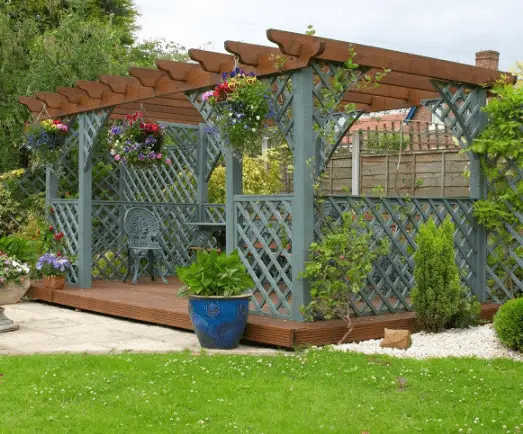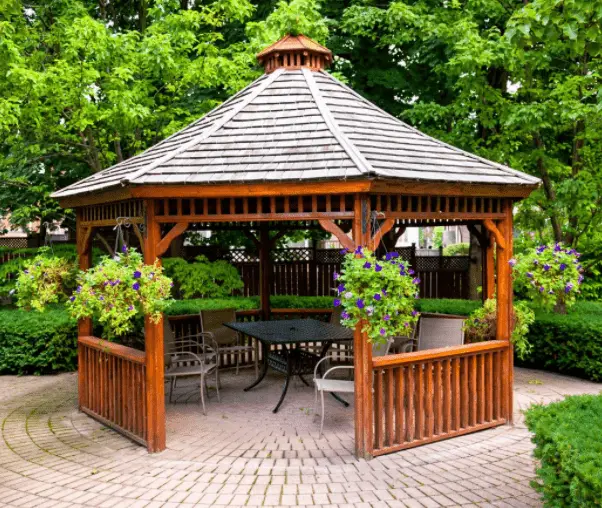Pergolas and gazebos are popular structures in gardens, parks and backyards. They are commonly used as partial coverings over patios and decks to offer protection from elements. These spectacular structures can also transform the appearance of a backyard and make it a great place for entertainment.
Many people confuse a pergola for a gazebo and vice versa. It is important if we help you understand the difference between the two, their pros and cons. This will help you make a sound decision when planning to have one of these structures installed in your backyard.
Pergola Vs Gazebo – Differences
| Pergola | Gazebo |
| Cost cheaper and takes less time to construct without need for skilled labor | Expensive to construct in terms of material and required skilled labor |
| Usually open for a clear view and free flow of breeze | The design may not allow clear view of your garden and landscape marvels |
| The open structure may not be comfortable in extreme weather elements | Perfectly protected from most weather elements including rains and hot sun |
| Can be a challenge to power the structure for addition of electric heaters and lighting | Easy to power the structure and add your patio heaters, fans and lights |
| Open pergola structures does not provide any protection to your outdoor furniture and properties from elements | The room adequately provides protection for your outdoor furniture and other installations |
| Can be installed in small backyards with limited space | The structure requires sufficient space otherwise you may not install it in a squeezed backyard |
| The wood used need to be treated otherwise your structure will not last long in elements | The structure itself is protected from the elements with its own roof which guarantees a long lifespan |
Pergola

A pergola is an outdoor structure with vertical pillars supporting cross-beams the top and open lattice on the sides where climbing vines are trained to add visual interest and shade to a garden.
Pergolas are typically open, without any plant canopy, and rain or sunlight will pass through it to the ground below.
A pergola with fully established vines around it can provide some backyard privacy and neighbors will not have a full view of your activities in the structure. Further, it can block some sunlight and you can enjoy your gatherings in peace without getting scorched.
Materials commonly used for construction of a pergola include wood and aluminum. Stones, concrete and brick can also be used on its floor and for the reinforcement of the pillars or poles in the ground. The cost of installing a pergola largely depends on its size, design and your location.
Pros
Construction of a pergola comes with the following advantages
- They are relatively cheap and faster to construct than most garden structures such as pavilion and gazebo.
- It provides a cool breeze on walkways, patios and other outdoor areas due to its open structure that allows free movement of air
- A pergola requires little maintenance once established. You will only need to train the vines and do some pruning
- A well done pergola will typically add value to your home or property thus the ideal project when you have plants to resell your home or venture into real estate
- Installation of a pergola can be a do it yourself cheap project that will not drain your pocket
- Pergola attached to a house to help save space in your backyard
- You can grow fruit vines such as passion flower and grapes on this structure
- Climbing flowers and vines such as Roses, Bougainvillea, Clematis and others adds color and breeze to a landscape
Cons
A pergola also has some shortcoming including the following
- The whole project looks unfinished until you grow some plants on the pergola
- It does not offer proper protection from elements due to its open roof. You will have to call off your outdoor events or gathering when rain comes or during a hot summer
- During the night mosquitoes and other insects roam freely through the open structure and you won’t have peace chilling there.
- Wood need to be treated to last longer and resist elements. This can turn to be a costly maintenance process
- There are no varieties when it comes to shapes and you are only limited to round or rectangular models
- Powering a pergola with electricity can be a great challenge due to exposure to rain
Gazebo

A gazebo is a freestanding outdoor structure with a covered roof supported by strong pillars and has open sides. It provides great shade and shelter from rain and UV radiations.
This ornamental structure is usually round in shape, but sometimes octagonal or hexagonal. It is also acceptable to attach a gazebo to a wall or house especially when you don’t have plenty of space in your backyard.
Most gazebos are typically built of wood and covered with standard roofing materials. Aluminum, wrought iron, brick and stone can also be used on the sides in place of wood. Gazebos may include screens to keep away mosquitoes and other pesky insects or winds. This means you can spend more time outside even into the night.
The cost of installing a gazebo also vary depending on the size of the structure, supply of the materials and design. A gazebo is structurally complex as compared to a pergola and may require skilled manpower for its construction.
Since a gazebo is usually covered, it is possible to install electric power which you can use for lighting and powering of your outdoor electric patio heater, TV or music system. This makes a gazebo a more entertaining place where you can lounge or party with your friends and family.
Pros
Installation of a gazebo comes with the following benefits
- A gazebo can be designed to offer full protection from elements including rain, winds and sun
- The structure not only add resale value to a home but also makes it highly attractive
- A gazebo helps in blocking neighbors view to provide maximum backyard privacy
- It is a place you will fully enjoy outdoor in comfort and style without interruption from mosquitoes, winds, rains and even neighbors.
- Maintaining a gazebo is manageable since debris and rain are barred from entering
- Gazebos are sturdy and durable structures that will serve you for many years without any issue
- They also offer protection to your outdoor furnishings including furniture
Cons
Things that will make you think twice before you install a gazebo include the following
- Gazebos are expensive to construct as compared to pergolas. In addition to the high cost of the material, skilled labor is required to set up a nice looking structure
- You will need a spacious backyard if you want your structure to appear decent. Large gazebos in small backyards look out of place.
- You will not enjoy a free breeze of air in a screened gazebo and somewhat you will feel like you are indoors.
Which is Better?
Both gazebos and pergolas are excellent outdoor structures that will add value and aesthetic appeal to your home. However, for full protection from elements, a gazebo carries the day. But when it comes to creating a special natural blend of your outdoor space, then a pergola with vines is a great option.
However, your choice on pergola or gazebo comes down to personal preference. It also depends on your budget, available space and its intended use.